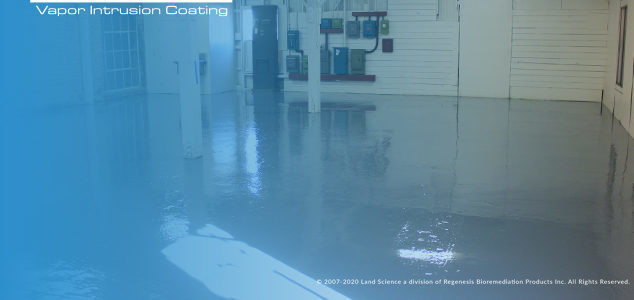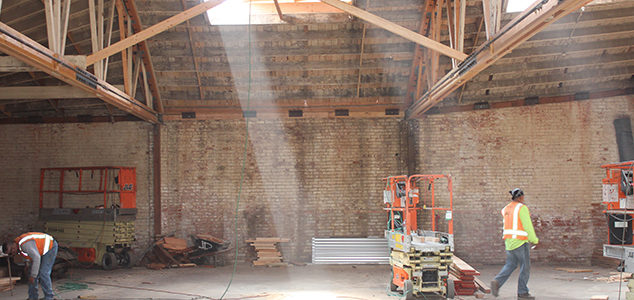Historic Building Achieves Site Closure Using Retro‐Coat to Meet Environmental Screening Levels
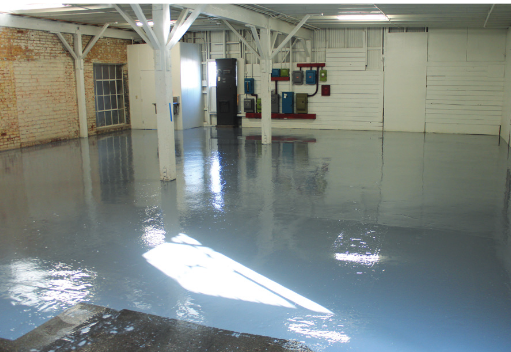 Project Highlights
Project Highlights
- Site achieves closure due to the successful Retro‐Coat™ application
- Post‐application indoor air data confirmed Retro‐Coat compliance with residential and commercial ESLs
- Customized finish met building owner requirements
- The application of Retro‐Coat achieved orders of magnitude reduction similar to those of Sub‐Slab Depressurization (SSD) Systems without the need to operate and maintain finicky mechanical systems
Project Summary
Retro‐Coat was selected to mitigate vapor intrusion within a structure built in 1907 that had been impacted by both a former underground storage tank and a local dry cleaner. Indoor air samples taken prior to application showed chlorinated solvent‐based PCE and TCE levels above the Regional Water Quality Control Board Environmental Screening Levels (RWQCB ESL).
Existing wood flooring, CMU block walls, framing obstructions on the wall, and conduits penetrating both the basement floor and walls presented challenges to successfully providing vapor intrusion mitigation to the entire basement area. The age of the structure was also a factor because little was known about how the building was constructed or what expansions or improvements
 had been made over the years. The building owner sought to provide the future occupants of the building with vapor intrusion protection using a durable and slip resistant coating. Retro‐Coat was applied to the existing wall surface (CMU block walls) and across the floor. Additionally, a silica sand was broadcast across the floor during the Retro‐Coat application to achieve a non‐slip surface.
had been made over the years. The building owner sought to provide the future occupants of the building with vapor intrusion protection using a durable and slip resistant coating. Retro‐Coat was applied to the existing wall surface (CMU block walls) and across the floor. Additionally, a silica sand was broadcast across the floor during the Retro‐Coat application to achieve a non‐slip surface.
Upon completion of the Retro‐Coat application, indoor air samples were collected. Because the building use was mixed use, indoor air concentrations needed to meet both residential and commercial screening levels. The application of Retro‐Coat achieved orders of magnitude reduction similar to those of Sub‐Slab Depressurization (SSD) Systems without the need to operate and maintain unreliable mechanical systems.
Technology Description
Retro‐Coat Vapor Intrusion Coating System is a complete product line that consists of chemically resistant materials to protect existing structures from the threat of contaminant vapor intrusion without the need for additional concrete protection. The Retro‐Coat system has been subjected to rigorous testing procedures to prove its ability to combat the most aggressive chemical vapors. The system is rated for industrial use providing a durable finished surface suitable for vehicular traffic. Retro‐Coat coating technology was specifically developed for vapor intrusion.
Combined Technologies Treat High Vapor and TCE Levels at Former Michigan Manufacturing Facility
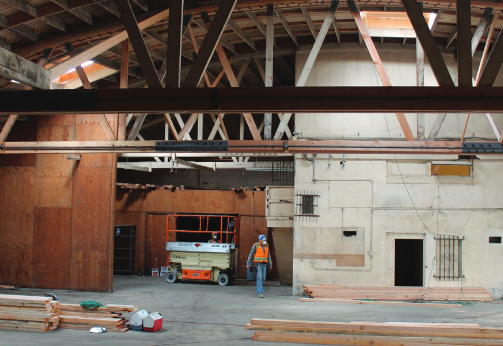 Project highlights
Project highlights
- Redeveloped facility delivers jobs to Michigan community
- Simultaneous use of Retro-Coat™ and Vapor-Vent™ reduced number of SSD points
- Approximately 30,000 square feet of Retro-Coat successfully applied
- Retro‐Coat provided a durable finish for vehicle traffic and heavy equipment in a manufacturing setting
Project summary
St. Johns-based F.C. Mason company was provided a $1 million Clean Michigan Initiative Brownfields grant from the Michigan Department of Environmental Quality (MDEQ) to move its operations to the former Federal Mogul manufacturing facility which was vacated in 2008. F.C. Mason Company was founded in 1898 and specializes in manufacturing parts for agricultural, construction and industrial equipment. The acquisition of the 265,00-square-foot facility allows F.C. Mason Company to expand operations and bring back valuable jobs to Clinton County. Michigan-based Soil and Materials Engineers, Inc. (SME) was consulted to address the suspected environmental and vapor intrusion concerns resulting from years of manufacturing activities at the site.
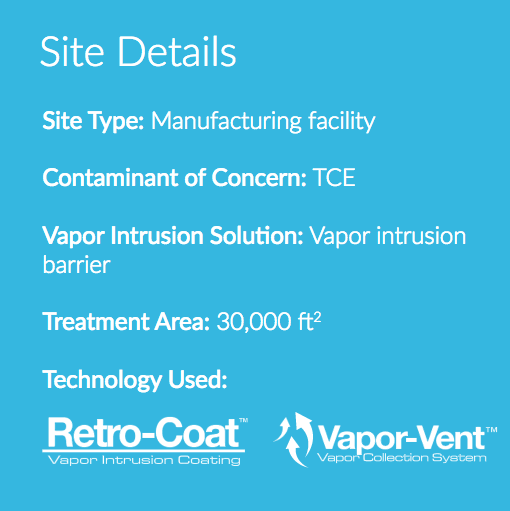 Trichloroethylene (TCE) contaminated areas were present in one section of the building. In 2009, in situ chemical treatment of the “hot spot” areas was conducted employing RegenOx® technology (REGENESIS®, San Clemente, CA). However, a vapor intrusion condition was later identified and mitigation was needed. Retro‐Coat was selected to be used in conjunction with an active sub‐slab depressurization (SSD) system. By simultaneously utilizing the two mitigation approaches, SME was able to reduce the number of SSD points in the design and the total area requiring the vapor intrusion barrier coating. MDEQ approved of the plan. A certified Retro‐Coat applicator installed 6 mils of red Retro-Coat Primer and 20 mils of grey Retro-Coat along with a broadcasted aggregate to provide a non-slip surface. The contrast in color between Primer and Retro-Coat allows the clear identification of wear over time, prompting repair if needed, and ensuring long‐term protection from vapor intrusion.
Trichloroethylene (TCE) contaminated areas were present in one section of the building. In 2009, in situ chemical treatment of the “hot spot” areas was conducted employing RegenOx® technology (REGENESIS®, San Clemente, CA). However, a vapor intrusion condition was later identified and mitigation was needed. Retro‐Coat was selected to be used in conjunction with an active sub‐slab depressurization (SSD) system. By simultaneously utilizing the two mitigation approaches, SME was able to reduce the number of SSD points in the design and the total area requiring the vapor intrusion barrier coating. MDEQ approved of the plan. A certified Retro‐Coat applicator installed 6 mils of red Retro-Coat Primer and 20 mils of grey Retro-Coat along with a broadcasted aggregate to provide a non-slip surface. The contrast in color between Primer and Retro-Coat allows the clear identification of wear over time, prompting repair if needed, and ensuring long‐term protection from vapor intrusion.
Technology Description
Retro‐Coat Vapor Intrusion Coating System is a complete product line that consists of chemically resistant materials to protect existing structures from the threat of contaminant vapor intrusion without the need for additional concrete protection. The Retro‐Coat system has been subjected to rigorous testing procedures to prove its ability to combat the most aggressive chemical vapors. The system is rated for industrial use providing a durable finished surface suitable for vehicular traffic. Retro‐Coat coating technology was specifically developed for vapor intrusion.
Vapor‐Vent is a low profile vent system that can be used in lieu of slotted PVC pipe. The speed of installation and the proximity of the vent to the barrier provide cost savings and performance benefits compared to other technologies.


